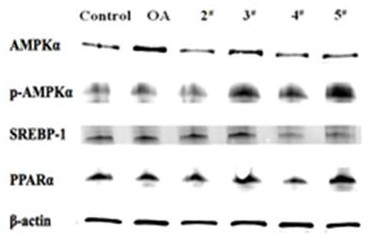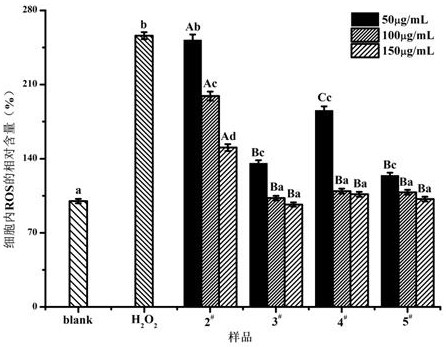Uses of Rosa tomentosa Fruit Extract
A technology of extracts and roses, which is applied in the directions of medical preparations, applications, and drug combinations containing active ingredients to achieve the effect of inhibiting deposition and high safety.
- Summary
- Abstract
- Description
- Claims
- Application Information
AI Technical Summary
Problems solved by technology
Method used
Image
Examples
Embodiment 1
[0019] Preparation of various phenolic components of Rosa tomentosa fruit: Freeze-dry and pulverize Rosa tomophy fruit fruit, extract Rosa tomentosa fruit powder ultrasonically with 80% methanol solution, the solid-liquid ratio g:mL is 1:5, Ultrasonic extraction at 40°C for 30min, filtration, repeated extraction of the filter residue twice, combined filtrate; low pressure, 40°C rotary evaporation concentrated to obtain sample 1; the concentrated solution was passed through ion exchange resin (Ameberlite XAD-7), with a mass concentration of 1% Wash the column with formic acid aqueous solution to remove non-polyphenolic substances (such as sugar, protein, etc.), then elute with methanol to obtain polyphenolic substances, collect the methanol eluate, spin evaporate, concentrate, and freeze-dry to obtain the crude polyphenols of Rosa tomentosa fruit. The extract, weighed, and stored at -20°C, is sample 2; take sample 2, dissolve it in pure water, and put it on Sephadex LH-20, and t...
Embodiment 2
[0021] Determination of the total phenol content in the phenolic components of Rosa tomentosa fruit: Dissolve the freeze-dried sample with 80% methanol solution to make a 1mg / mL sample solution, take 1mL and add it to a 10mL centrifuge tube, then add 6mL distilled water and 0.5mL folinol, after mixing, add 1.5mL mass concentration 20% Na 2 CO 3 Finally, distill the entire reaction system to 10 mL with distilled water; return to room temperature after a 70°C water bath (10 min), and measure the absorbance at 765 nm with a microplate reader. Using gallic acid as the equivalent to make a standard curve, the total phenolic content of the sample is expressed as: mg gallic acid / g dry weight of the extract, and the results are shown in Table 1;
[0022] Content of total flavonoids in each material component of Rosa tomentosa fruit: dissolve the freeze-dried extract with 70% ethanol, take 1mL sample solution in a centrifuge tube, add 2.5 mL 70% ethanol, and then add 0.15 mL 5% NaNO ...
Embodiment 3
[0026] Embodiment 3: Using UHPLC-ESI-MS to analyze the compound composition in the fruit of Rosa tomentosa, the specific operations are as follows:
[0027]UHPLC-ESI-HRMS / MS was used to conduct qualitative and quantitative analysis of phenolic substances in the phenolic components of Rosa tomentosa fruit; the chromatographic conditions of the liquid phase were Reprospher 100 C18 analytical column (1.8 μm, 100 × 2 mm), The mobile phase was 0.1% formic acid water (A) and mass spectrometry grade acetonitrile (B), the flow rate was 0.3 mL / min, the injection volume was 3 µL, and the column temperature was set at 35 °C. The more suitable mobile phase gradient is: 0.01 min, 5% (B); 3 min, 11% (B); 12 min, 13% (B); 14 min, 18.5% (B); 20 min, 18.5% ( B); 26 min, 35% (B); 26.5 min, 52% (B); 28 min, 52% (B); the main mass spectrometer condition is full scan (150~1000 m / z); ESI ion source temperature The temperature was 320°C; the ionization voltage was 3.2kV; the auxiliary air flow was ...
PUM
 Login to View More
Login to View More Abstract
Description
Claims
Application Information
 Login to View More
Login to View More - R&D
- Intellectual Property
- Life Sciences
- Materials
- Tech Scout
- Unparalleled Data Quality
- Higher Quality Content
- 60% Fewer Hallucinations
Browse by: Latest US Patents, China's latest patents, Technical Efficacy Thesaurus, Application Domain, Technology Topic, Popular Technical Reports.
© 2025 PatSnap. All rights reserved.Legal|Privacy policy|Modern Slavery Act Transparency Statement|Sitemap|About US| Contact US: help@patsnap.com



